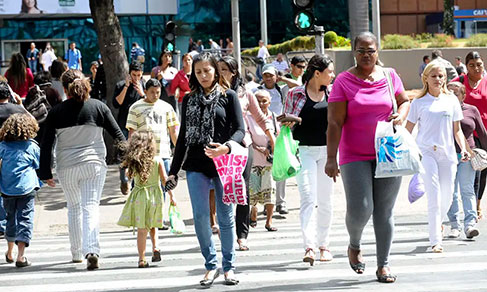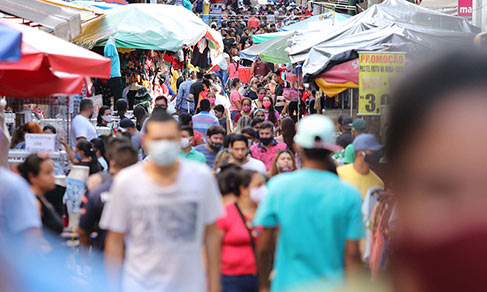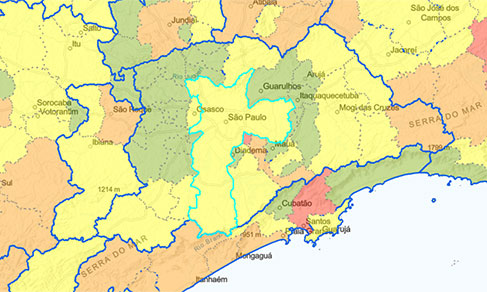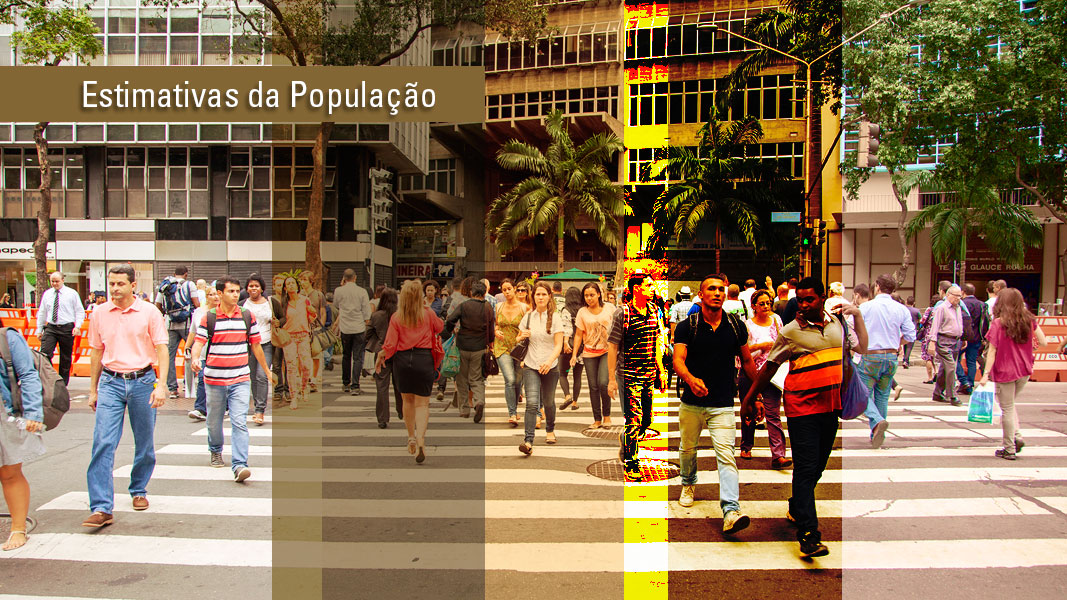Nossos serviços estão apresentando instabilidade no momento. Algumas informações podem não estar disponíveis.
Population Estimates
Tables - 2025
Estimativas de população publicadas no DOU
Tabelas de estimativas populacionais para os municípios e para as Unidades da Federação brasileiros em 01.07.2025:
PDF | ODS | XLS
Atendendo ao dispositivo legal, Lei nº 8443, de 16 de julho de 1992, no artigo 102, o IBGE fez publicar no Diário Oficial da União, em 28 de agosto de 2025, as estimativas de população para os Municípios e para as Unidades da Federação, com data de referência em 1º de julho de 2025. A Lei complementar nº 143, de 17 de julho de 2013, alterou o art. 102 da Lei nº 8443, revogando os parágrafos 1º e 2º, que estabelecia o prazo de 20 dias após a publicação das Estimativas no Diário Oficial da União para apresentação de reclamações ao IBGE.
Para fins do Fundo de Participação dos Municípios (FPM), a municipalidade beneficiada por decisão judicial deverá, no prazo administrativo, informar o IBGE acerca da vigência das decisões antecipatórias de mérito listadas na publicação do Diário Oficial da União.
- Decisões Judiciais que alteraram coeficientes do Fundo de Participação dos Municípios (pdf)
Population estimates published in DOU
Tables of population estimates for the Brazilian municipalities and Federation Units on July 1, 2025:
PDF | ODS | XLSComplying with article 102 of Law no. 8,443, of July 16, 1992, the IBGE published in the Official Gazette, on August 28, 2025, the population estimates for the Brazilian municipalities and Federation Units, based on the reference date of July 1, 2025. Complementary Law no. 143, of July 17, 2013, changed article 102 of Law no. 8,443, revoking paragraphs 1 and 2, which established the deadline of 20 days after the publication of the estimates in the Official Gazette to send complaints to the IBGE.
For the purposes of the Municipal Participation Fund (FPM), the municipality benefited by judicial decisions shall, within the administrative period, inform the IBGE on the validity of the anticipatory decisions of merit listed in the publication of the Official Gazette.
The IBGE adopts a review policy of the data disclosed by this statistical operation. Data review means any and all scheduled revision of numerical data due to new information, which was not accessible at the time of the first disclosure. For instance: late data that replaces a non-response; or data corrected by the informant himself; or a set of data that has undergone editing and imputation. For more detailed information about the published data review policy of the IBGE statistical operations, check the list of short-term, long-term and special surveys carried out by the Institute with their respective revision procedure on: https://biblioteca.ibge.gov.br/index.php/biblioteca-catalogo?view=detalhes&id=298009.
Concepts and methods - 2025
As informações a seguir descrevem os metadados estatísticos, que são o conjunto de conceitos, métodos e aspectos relacionados às estatísticas, e são informações necessárias para compreender as características e a qualidade das estatísticas e interpretá-las corretamente.
Informações Gerais
Objetivo
As Estimativas da População Residente para os Municípios e para as Unidades da Federação, com data de referência em 1º de julho são importantes para indicar o quantitativo populacional total dos municípios, para os quais não se elaboram projeções populacionais de curto ou longo prazo. Além disso, em cumprimento ao dispositivo constitucional, as estimativas da população constituem o principal parâmetro para a distribuição, conduzida pelo Tribunal de Contas da União, das quotas partes relativas ao Fundo de Participação de Estados e Municípios.Tipo de operação estatística
Projeções e estimativas populacionaisTipo de dados
Projeções e estimativas populacionaisPeriodicidade de divulgação
AnualMetodologia
Técnica de coleta:
Não se aplicaTemas
Temas e subtemas
População, Características gerais da populaçãoPrincipais variáveis
População total do Brasil, Unidades da Federação e MunicípiosPalavras-chave
População municipal, Estimativas municipaisUnidades de informação
Unidade de investigação
PessoaUnidade de análise
PessoaUnidade informante
Não se aplica.Períodos de referência
Disseminação
Formas de disseminação
Publicação Digital (online), Diário Oficial da UniãoNível de desagregação geográfica
MunicípioNível de divulgação
Brasil, Unidades da Federação e MunicípiosHistórico
Saiba mais
https://metadados.ibge.gov.br/consulta/estatisticos/operacoes-estatisticas/XFDescription
It provides estimates for the total population of the Brazilian Municipalities and Federation Units, based on July 1st of the current calendar year.
The IBGE releases the state and municipal population estimates since 1975. From 1992 onward, it is published in the Brazilian Official Gazette, according to the Article 102 of Law no. 8,443, of July 16, 1992, to meet Item VI of Article 1st of that law. In 2013, Complementary Law no. 143, of July 17, 2013, established that an authorized entity of the federal executive power will publish every year in the Brazilian Official Gazette the population of the Municipalities up to August 31 and the population of the States and Federal District up to December 31. It should be highlighted that the municipal populations are the most important input used by the Brazilian Court of Audit to distribute the States and Federal District Revenue Sharing Fund - FPE and the Municipal Revenue Sharing Fund - FPM.
The population estimates annually published are calculated based on the mathematical method developed in 1972 by João Lira Madeira and Celso Cardoso da Silva Simões, called AiBi. This method uses as basic input the populations obtained from the most recent Population Projections for Brazil and Federation Units, as well as the population growth of every Municipality in the last decade, outlined by their respective populations enumerated in the last two Population Censuses. Those enumerated populations, which are the basis for calculating the trend of population growth in the Municipalities, can be adjusted according to the population adjustments used in the Population Projections for Brazil and Federation Units.
In addition to the basic inputs above mentioned, the municipal population estimates incorporate every year updates of the political-administrative division of Brazil, which, on their turn, reflect the changes in the territorial boundaries of the Municipalities taken place after the last Population Census. Since the sum of the populations of the Municipalities results in the total population of the respective Federation Unit, likely differences between the total population of a Federation Unit obtained from the Population Estimates and that obtained from the Population Projections result from the update of the political-administrative division taken place after the base year of the projections (and, thus, not taken into account in the Population Projections of the Federation Units).
Important note
The IBGE does not produce population projections at the municipal geographic level. The Population Projections for Brazil and Federation Units are prospective, estimated by demographic methods, whose current horizon is up to 2060. The projected populations are released by sex and age group, allowing the analysis of the evolution of the size and age structure of the population. For more detailed information on this theme, see Population Projections.
Technical Information
Methodological notes
- Methodological notes - Updated on July 1, 2017
- Methodological notes - Updated on July 1, 2016
- Methodological notes - Updated on July 1, 2015
- Methodological notes - Updated on July 1, 2014
- Methodological notes - Updated on July 1, 2013
- Methodological notes - Updated on July 1, 2012
- Methodological notes - Updated on July 1, 2011
- Methodological notes - Updated on July 1, 2008
News and Releases
Country's estimated population reaches 213.4 million residents in 2025
According to the Population Estimates, released today (28) by the IBGE, the Brazilian population reached...
28/08/2025
Brazil's estimated population will reach 212.6 million residents in 2024
Today (29), the IBGE (Brazilian Institute of Geography and Statistics) released estimates of the populations...
29/08/2024
IBGE releases population estimates of municipalities for 2021
The IBGE releases today the estimates for the resident population in the 5,570 Brazilian municipalities....
27/08/2021
Population estimated for Brazil reaches 213.3 million inhabitants in 2021
According to the Population Estimates released today (27) by the IBGE, the number of Brazilian inhabitants...
27/08/2021
IBGE launches interactive dashboard to help municipalities fight the pandemic
The IBGE launches today (21) the Covid-19 Dashboard by Municipality, with interactive maps that enable...
21/09/2020
IBGE releases population estimate of municipalities for 2020
The IBGE released today the estimates of the resident population for the 5,570 Brazilian municipalities,...
27/08/2020
IBGE estimates Brazilian population at 211.8 million inhabitants
According to the Population Estimates released today (27) by the IBGE for the 5,570 municipalities, Brazil...
27/08/2020
IBGE discloses municipal population estimates for 2019
The IBGE discloses today the estimates of the population living in the 5,570 Brazilian municipalities, taking...
28/08/2019
One out of three Brazilians lives in 48 municipalites with more than 500 thousand inhabitants
Nearly 66.5 million Brazilians (31.7%) live in the 48 municipalities with more than 500 thousand inhabitants...
28/08/2019
Errata
Calendar error in the release of 2023 Population Estimates
Published date: 31/07/2023
Description:
Error, pinpointed by the IBGE, for not meeting the release month (August) of the 2023 Population Estimates, according to calendar published in December 2022. Complying with Art. 102 of Law no. 8,443, of July 16, 1992, the populations of the 2022 Population Census will be published in the Official Gazette on August 30, 2023, including updatings in the territorial borders informed to the IBGE between August 1, 2022 and April 30, 2023, under the scope of technical cooperation agreements signed with state offices, aiming at the consolidation of the borders.Actions: The release calendar has been changed.
Amendment of 2020 Population Estimates for three municipalities in Maranhão
Published date: 17/11/2021
Description:
The Population Estimates, based on July 1, 2020, for the municipalities of Fortuna, Governador Eugênio Barros and Governador Luis Rocha, in the state of Maranhão, were published with errors.Actions: Amendment of these Population Estimates on the portal, BME and SIDRA, as well a notification letter sent to the Brazilian Court of Audit.
Amendment of the release Population Estimates 2017
Published date: 31/08/2017
Description: The errors refer to a support graph in the release (graph 1), two paragraphs of the release which refer to the graph, and the population 2017 of the municipality of Poção de Pedras - MA, in a support table of the release.
Actions: Replacement of files (tables and release).
Rectification of Population Estimates 2016
Published date: 12/09/2016
Description: There was a processing error in the report issued on the Change Monitoring System of Territorial Boundaries - SALT and the territorial changes in three municipalities of the State of Bahia together with another three in Maranhão which were not properly incorporated to the population estimates of 2016: The municipalities were Piritiba (BA), Tapiramutá (BA), Morro do Chapéu (BA), Urbano Santos (MA), Barreirinhas (MA) and Santa Quitéria do Maranhão (MA).
Actions: Rectifications in the Official Gazette provided on September 09 of 2016. Population estimates in the Municipalities of Maranhão: Urbano Santos, Barreirinhas and Santa Quitéria do Maranhão amended and files replaced in the IBGE website on September 12 of 2016. Population estimates in the Municipalities of Bahia: Piritiba, Tapiramutá e Morro do Chapéu amended and files replaced in the IBGE website on September 13 of 2016, and update note included in the web page giving access to the files.












